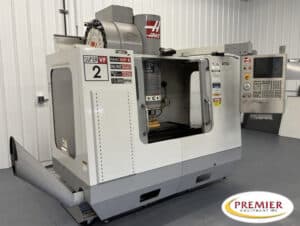CNC machines are widely used in the manufacturing industry, and as the demand for products continues, there will be an increase in the demand for those able to program, operate and maintain CNC machine tools. You may see a variety of names used in an employment advertisement for CNC machining positions, something for a CNC machinist and other times for a CNC operator. There is a difference between these two positions, whether the job is for a new or used CNC machine. Here’s how to tell the jobs apart.
What Is a CNC Operator?
When you look at the word operator, it is a simple term for a person who operates or runs a machine. This is an entry-level approach to working with new or used CNC machines, as these individuals need a basic understanding of how to run the machine. CNC machine tools are designed to run autonomously according to a preset program. An operator isn’t responsible for setting up the program but rather pushing the buttons and preparing the machine itself.
The day-to-day basics for an operator include monitoring the progress of the job, troubleshooting problems that come up and changing out necessary parts. At times, the operator may need to tweak the program or adjust the tooling, but the operator doesn’t have to work from scratch.
What Is a CNC Machinist?
In contrast with an operator, you will find a CNC machinist to be a next-level specialist in both the CNC tool itself and machining. Machinists could start with the foundational training in CNC programming or they could acquire the skills they need on the job. With a strong technical knowledge that deals with how to program a CNC machine and plenty of practical experience with machining, the machinist is able to develop and design programs for the tool that produce high-quality results.
A machinist can be considered a step up from an operator because of the additional skills they bring to the tooling project. In addition to running the machine, a machinist is able to determine which operations should be a part of a specific program. The machinist can also create a specific machining program to reach the desired product result.
What Is the Path Between Positions?
Some consider there to be three different types of CNC machine operators, and those who start out in one specialty can often move into another area after significant training on the job experience. Beginning operations do the basic jobs of load or unloading parts before starting the CNC tool. These operators don’t require much training or experience to work with the tools. Set-up operators are the next-level operators as they know the basic programming and troubleshooting needs of a CNC machine. These folks have some blueprint reading skills and can initiate the programs.
While set-up operators can make minor program adjustments, the CNC programmers are the ones who have the most in-depth knowledge of crafting the programs to run the machine. With enough experience and training in things like safety protocols, technical documentation, machine operations and programming, individuals can work up to the role of machinist. Taking a training program or certification course can help those who are interested advance more quickly into a role as a CNC machinist.
Find the Best Used CNC Machines
Premier Equipment is the largest seller of affordable used CNC machines. Contact our team to find out about which used CNC machine for sale can help improve your production rates.



